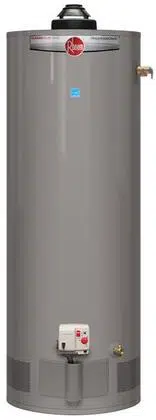Loading ...
Loading ...
Loading ...

Thermal Expansion
Determine if a check valve exists in the inlet
water line. Check with your local water utility
company. It may have been installed in the cold
water line as a separate back flow preventer,
or it may be part of a pressure reducing valve,
water meter or water softener. A check valve
located in the cold water inlet line can cause
what is referred to as a “closed water system”.
A cold water inlet line with no check valve or
back flow prevention device is referred to as an
“open” water system.
As water is heated, it expands in volume and
creates an increase in the pressure within the
water system. This action is referred to as “ther-
mal expansion”. In an “open” water system,
expanding water which exceeds the capacity of
the water heater flows back into the city main
where the pressure is easily dissipated.
A “closed water system”, however, prevents
the expanding water from flowing back into the
main supply line, and the result of “thermal
expansion” can create a rapid and dangerous
pressure increase in the water heater and system
piping. This rapid pressure increase can quickly
reach the safety setting of the relief valve, caus-
ing it to operate during each heating cycle.
Thermal expansion, and the resulting rapid, and
repeated expansion and contraction of compo-
nents in the water heater and piping system can
cause premature failure of the relief valve, and
possibly the heater itself. Replacing the relief
valve will not correct the problem!
The suggested method of controlling thermal
expansion is to install an expansion tank in the
cold water line between the water heater and
the check valve (see illustration on page 9). The
expansion tank is designed with an air cushion
built in that compresses as the system pressure
increases, thereby relieving the over pressure
condition and eliminating the repeated operation
of the relief valve. Other methods of controlling
thermal expansion are also available. Contact
your installing contractor, water supplier or
plumbing inspector for additional information
regarding this subject.
8
Installing the Water Heater
Corrosive Atmospheres
The air in beauty shops, dry cleaning establish-
ments, photo processing labs, and storage areas
for liquid and powdered bleaches or swim-
ming pool chemicals often contain halogenated
hydrocarbons.
An air supply containing halogenated hydro-
carbons may be safe to breathe, but when it
passes through a gas flame corrosive elements
are released that will shorten the life of any gas
burning appliance.
Propellants from common spray cans or gas
leaks from A/C and refrigeration equipment are
highly corrosive after passing through a flame.
The water heater warranty is voided when fail-
ure of the heater is due to operation in a corro-
sive atmosphere.
NOTICE: The
water heater must
not be installed
near an air supply
containing halogenated
hydrocarbons.
Refer to the following illustration for suggested
typical installation. The installation of unions
or flexible copper connectors are recommended
on the hot and cold water connections so that
the water heater may be easily disconnected for
servicing if necessary. The HOT and COLD
water connections are clearly marked on the
water heater. Install a shutoff valve in the cold
water line near the water heater. Refer to the
following illustration for suggested typical
installation.
IMPORTANT
For models equipped with a Top Cap, it is rec-
ommended that the hot and cold water piping
have a minimum vertical height of 10 inches
(25.4 cm) from the top of the water heater
before transitioning into any elbow. This verti-
cal height is needed in order to provide adequate
clearance for Top Cap installation and removal.
To gain access to the hot and cold water con-
nections on models equipped with a Top Cap,
remove the two (2) screws that secure the top
cap to the water heater then pull the Top Cap
upward and off the water heater. See illustra-
tion of Top Cap and screws on pages 31 & 43.
Water Supply Connections
IMPORTANT: Do
not apply heat to the
HOT or COLD water
connections. If sweat
connections are used,
sweat tubing to adapter
before fitting adapter
to the cold water
connections on heater.
Any heat applied to
the cold water supply
fittings will permanently
damage the dip tube and
heat traps.
Loading ...
Loading ...
Loading ...
